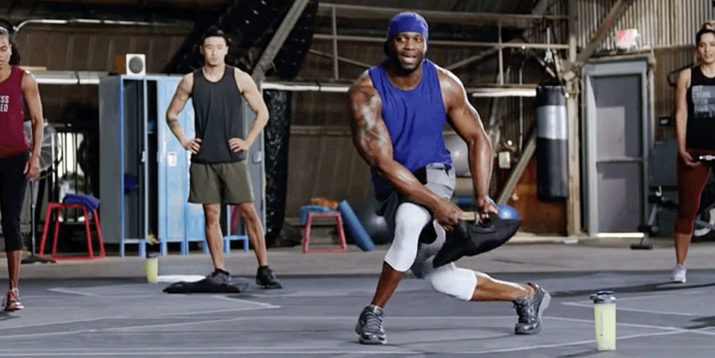How to Do a Curtsy Lunge (Video)

The curtsy lunge is inspired by the old-school curtsy’s behind-the-leg crossing motion, but the similarities end there.
While the move requires a certain amount of coordination, it doesn’t have to be graceful to be effective. In fact, sweating and grunting are encouraged.
There are no skirts or heels — curtsy lunge etiquette requires only sneakers and gym clothes.
And, of course, the move isn’t only for ladies; men benefit just as much from its muscle-strengthening capabilities.
How to Do a Curtsy Lunge With Perfect Form
- Stand with your feet hip-width apart and your hands on your hips or holding dumbbells by your sides.
- Keeping your back flat and your core engaged, step your left foot behind and outside your right foot, lowering your hips until your right thigh is parallel with the floor. Your left knee should hover an inch or two above the floor.
- Reverse the movement to return to the starting position. Continue for reps, then switch sides and repeat.
How to Make the Curtsy Lunge Easier
It may take time to master the curtsy lunge’s form and foot placement, so start slow.
Bodyweight curtsy lunges offer beginners plenty of resistance, so there’s no need to use dumbbells or sandbags at first.
You can also decrease the intensity of the move by performing a shallower lunge.
How to Make the Curtsy Lunge Harder
As your strength increases, you may want to scale the curtsy lunge to increase its difficulty.
Braun suggests adding weight — holding a dumbbell, kettlebell, or sandbag at chest height, or at arm’s length by your sides — and/or using sliders, which are placed under the feet to exert more continuous tension on the muscles of the lower body.
Alternatively, you can mix up the tempo of your curtsy lunge. Slow down the overall pace, or pause at the bottom of the lunge, and you’ll feel your glutes, quads, and adductors working overtime to hold the position.
Or add pulses: At the bottom of each curtsy lunge, lower and raise your hips by an inch or two.
Repeat two to three times using a quick, pulse-like motion before returning to a standing position.
Benefits of the Curtsy Lunge
Like the squat and the standard lunge, curtsy lunges target the glutes and quads. So, if sculpting a shapely rear is a priority, go ahead and add the curtsy lunge to your repertoire.
But this lunge variation also has a few unique benefits. The crossing movement of the leg fires up the gluteus medius, an important stabilizing muscle located on the upper, outer portion of the butt that’s often overlooked and undertrained.
Beachbody fitness expert Cody Braun also notes the curtsy lunge’s activation of the adductors (the inner thigh muscles that pull the legs toward each other) as well as the movement’s overall level of difficulty compared to other types of lunges, like the side lunge.
“This variation of the lunge is a little more challenging to your flexibility and stability than a normal lunge,” he explains.
Variations on the Curtsy Lunge
The double cross, a variation on the curtsy lunge, turns the lower-body movement into a full-body exercise. The move, which requires a sandbag or a single dumbbell, uses the same lower-body movement pattern as the curtsy lunge.
But as you step one leg behind the other, you also lower the weight from one shoulder to the outside of the opposite leg.
This upper-body movement targets the shoulders and core muscles, including the obliques and transverse abdominis.
Double Cross
Appears in: SHIFT SHOP >> Super Strength :50
- Holding a sandbag (or dumbbell) at your left shoulder with both hands, stand with your feet hip-width apart. This is the starting position.
- Keep your back flat and your core engaged as you simultaneously step your left foot behind and outside your right leg and lower the sandbag across your body to just outside your right thigh.
- Reverse the movement to return to the starting position. Continue for reps, then switch sides and repeat.
What Muscles Are Used in a Curtsy Lunge?
Glutes
Your butt muscles are headlined by the gluteus maximus, which is most responsible aesthetically for the size and shape of your rear, and functionally for hip extension.
The gluteus medius, located a layer deeper, primarily handles abduction (lifting out to the side) and rotation of the leg.
Buried beneath both of the aforementioned is the baby of the bunch, gluteus minimus, which assists in rotation, abduction, and pelvic stabilization.
Quads
It takes four muscles to straighten your knee: the rectus femoris, which runs down the front of the femur (thighbone); the vastus lateralis, which forms the outside of your thigh; the vastus medialis, which is the teardrop-shaped muscle just above and to the inside of the knee; and the vastus intermedius, which runs underneath the rectus femoris.
Adductors
Located along your inner thighs, these ropy muscles are responsible for pulling your legs together.
Weakness in your adductors can cause limitations in your hip and knee stability, something targeted specifically by the curtsy lunge.





